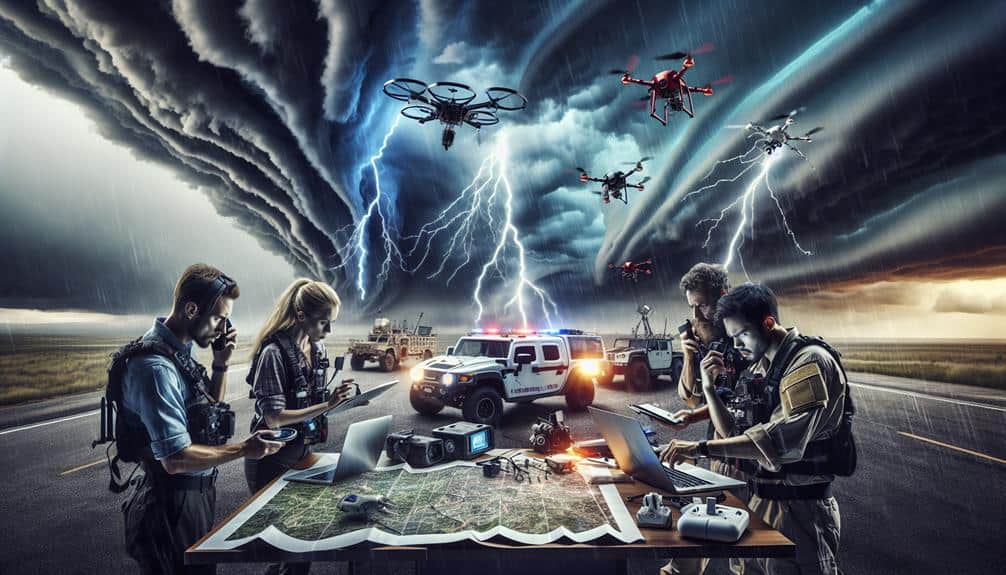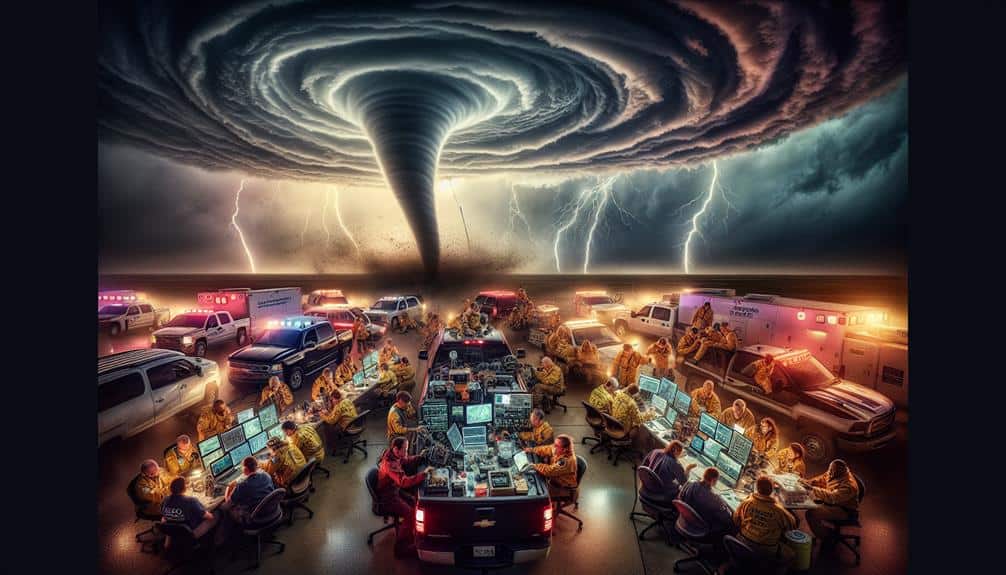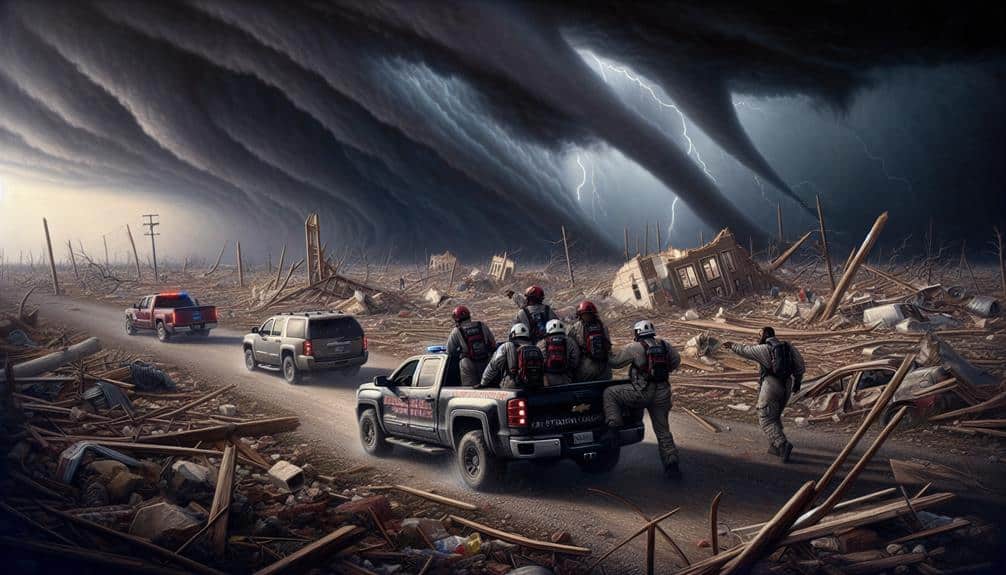As storm chasers, we've got to get emergency response coordination accurate to stay safe and effective. First, establish solid communication networks using satellite phones and dependable radios. We also need to leverage real-time data from weather stations and satellites, adjusting our strategies as necessary. Coordination with local authorities is vital; syncing our efforts guarantees well-informed decision-making. Safety should be top priority, with proper gear and strict protocols in place. Efficient resource management and thorough post-storm assessments are essential for sustained operations and community support. There's more to contemplate if we're committed to excelling in our emergency response roles.
Key Points
- Establish reliable communication networks and clear protocols for streamlined information flow.
- Sync efforts with local authorities and participate in emergency planning meetings and drills.
- Conduct real-time data analysis and adapt strategies for agile response.
- Prioritize team safety with proper gear, risk assessments, and emergency alert systems.
Establishing Communication Networks
In the critical moments before a storm hits, we've got to set up reliable communication networks to guarantee seamless emergency response coordination. When nature's fury is about to strike, every second counts, and our ability to communicate effectively can make all the difference.
We need a strong network establishment that integrates the latest technology, ensuring everyone from first responders to local authorities is on the same page. Our first priority is creating a resilient communication infrastructure. This involves deploying satellite phones, radio systems, and other reliable devices that won't fail under pressure. Technology integration is key; we must leverage advanced tools to maintain real-time connectivity. By doing so, we guarantee that our emergency response teams can relay critical information swiftly and accurately.
Next, we focus on communication strategies. Setting up clear protocols and hierarchies will prevent chaos and confusion. Everyone involved needs to know who to contact and when, fostering a streamlined flow of information. Practicing these strategies through regular drills can help iron out any kinks before an actual emergency strikes.
Leveraging Real-Time Data
With our communication networks firmly in place, we now focus on leveraging live data to enhance our emergency response efforts. We rely on cutting-edge data analysis to interpret the vast amounts of information collected during storms. This analysis helps us understand patterns, identify potential risks, and make informed decisions swiftly.
Live data streams from weather stations, satellites, and radar systems are our lifelines in these situations. We also employ predictive modeling to forecast storm trajectories and their potential impact areas. By integrating historical data with current observations, these models allow us to anticipate the storm's behavior and prepare accordingly.
This foresight is critical for deploying resources efficiently and ensuring the safety of both our team and the communities we serve. Access to live data and robust predictive tools empowers us to act with agility. We can adapt our strategies on the fly, making adjustments as new data comes in.
This proactive approach is key to minimizing damage and maximizing response effectiveness. In the domain of storm chasing, where conditions can change in an instant, the ability to leverage live data isn't just advantageous—it's essential.
Coordinating With Local Authorities
We work closely with local authorities to guarantee a unified and effective emergency response. Establishing strong community partnerships is essential for efficient storm chasing operations. By syncing our efforts with local support, we make sure that our actions are aligned with the needs of the community and the directives of local emergency management.
Government coordination is paramount. We engage in regular communication with local officials before, during, and after storm events. This allows us to share real-time data, helping them make informed decisions quickly. By doing so, we enhance their ability to deploy resources where they're most needed, minimizing risk and maximizing the impact of our combined efforts.
Our collaboration isn't just about sharing information; it's about building trust. We attend local emergency planning meetings, participate in drills, and offer our expertise to local agencies. These community partnerships fortify our emergency response capabilities and make sure that everyone involved is on the same page.
Ultimately, our goal is to create a seamless network of support that empowers both storm chasers and local authorities. Through effective government coordination and unwavering local support, we can better safeguard lives and property during severe weather events.
Ensuring Team Safety
To secure our team's safety, we must prioritize proper gear preparation. We'll double-check our equipment and establish clear communication protocols.
We'll maintain constant contact through reliable channels and implement thorough risk assessment procedures. By evaluating potential threats before they become hazards, we're prepared for any situation that might arise.
Proper Gear Preparation
Securing our team's safety starts with meticulously preparing and checking all gear before heading into a storm. We can't afford to overlook any aspect of gear maintenance. Every piece of equipment, from weather instruments to our vehicles, needs to be in top condition. Let's inspect our gear for any signs of wear and tear and replace faulty items immediately. Reliability isn't an option; it's a necessity.
Emergency supplies are just as essential. We need to stock up on essentials like first aid kits, water, non-perishable food, and thermal blankets. In the unpredictable nature of storm chasing, having the right supplies can make the difference between a minor inconvenience and a life-threatening situation. We'll also guarantee our communication devices are fully charged and have backup batteries ready.
Let's not forget our personal protective equipment. Helmets, gloves, and sturdy footwear are non-negotiable. We should also carry high-visibility vests and rain gear to stay protected and visible in adverse conditions.
Communication Protocols
After securing our gear and supplies, let's establish our communication protocols to maintain team safety during storm chasing operations.
Effective communication is pivotal to our success and safety. First, we must set up a reliable system for emergency alerts and team updates. Each team member should have a communication device, whether it's a radio, smartphone, or satellite phone, and verify it's fully charged and operational.
Next, we'll designate a central communication hub where all updates and alerts are monitored. This hub is responsible for relaying clear instructions to the team in real-time. Quick response is essential, so we need to keep our messages concise and direct. It's also important to establish specific codes or phrases for different types of emergencies to avoid any confusion.
Regular check-ins are a must. Let's agree on time intervals for updates, even if there's nothing new to report. This keeps everyone aware of each other's status and location.
In the event of network failure, we should have a pre-determined meeting point or fallback communication method.
Risk Assessment Procedures
Conducting thorough risk evaluations is essential for maintaining our team's safety during storm chasing operations. We can't emphasize enough the importance of real-time weather monitoring. By consistently tracking storm patterns and forecasts, we can anticipate potential dangers and adjust our plans accordingly. This proactive approach allows us to stay ahead of the storm, avoiding unnecessary risks.
Field reconnaissance plays a crucial role in our risk evaluation procedures. Before heading out, we conduct on-the-ground assessments to understand the local terrain and identify any potential hazards. This hands-on approach ensures that we're well-prepared for the unique challenges each storm presents. By combining field reconnaissance with weather monitoring, we create a detailed safety plan that addresses multiple risk factors.
We must also communicate any potential risks to all team members promptly. Maintaining clear, constant communication ensures that everyone is aware of the current situation and can respond quickly to any changes. Regular briefings and updates keep the team informed and ready to act.
Managing Resources Efficiently

To manage resources efficiently, we must prioritize equipment allocation. Streamlining our communication channels is also crucial. Leveraging volunteer networks is another key strategy. By focusing on these areas, we'll guarantee our teams operate at maximum effectiveness during emergencies.
Let's break down each point to understand how we can optimize our efforts.
Prioritizing Equipment Allocation
Effective resource management begins with carefully prioritizing equipment allocation to guarantee our storm chasers have the tools they require when they need them. By focusing on strategic equipment distribution and streamlined team coordination, we guarantee that our efforts are both effective and efficient.
To achieve this, we should adhere to the following principles:
- Assess Equipment Needs: Analyze the specific needs of each storm-chasing team based on their roles and the anticipated conditions. This assists in distributing the appropriate tools to the suitable individuals.
- Optimize Inventory: Regularly review and update our equipment inventory. By monitoring what we possess and what we require, we prevent shortages and make sure that every team member is adequately equipped.
- Prioritize Critical Tools: Identify and prioritize the allocation of crucial equipment, such as communication devices, navigation tools, and safety gear, to guarantee that our teams can operate safely and effectively.
Streamlining Communication Channels
Streamlining our communication channels guarantees that every team member receives the right information at the right time, enhancing our overall operational efficiency. By leveraging cutting-edge communication technology, we make certain that our emergency response is swift and coordinated. Real-time data management tools play a pivotal role in this process, allowing us to capture, analyze, and disseminate critical information without delay.
In the heat of a storm chase, clear and concise communication is non-negotiable. We've got to establish a hierarchy of communication that prioritizes urgent messages and filters out the noise. With reliable communication technology, such as satellite phones and encrypted radio systems, we can maintain constant contact, even when conventional networks fail.
Effective team coordination hinges on streamlined communication. A centralized data management system means that all team members can access up-to-date information, enabling them to make informed decisions quickly. By integrating GPS tracking and weather data into our communication channels, we can monitor each member's location and status, ensuring their safety and optimizing resource allocation.
Let's not underestimate the power of efficient communication channels. They're the backbone of our operations, making sure that we're always one step ahead in our emergency response efforts.
Leveraging Volunteer Networks
Leveraging volunteer networks allows us to maximize resource efficiency and bolster our emergency response efforts. By tapping into the power of community volunteers, we can make certain a swift and coordinated response to storms and other emergencies.
Here's how we can make the most of our volunteer networks:
- Volunteer Recruitment and Training: We need to actively recruit volunteers who are passionate about helping during emergencies. Offering thorough training ensures they're prepared and confident in their roles.
- Network Coordination and Support: Effective communication and coordination are crucial. We should establish a clear structure for information flow, making sure everyone knows their responsibilities and how to access support.
- Resource Allocation: Volunteers often bring their own resources, such as vehicles and tools. By organizing these assets efficiently, we can fill gaps in our official resources, providing a more robust response.
Harnessing the power of volunteer networks not only amplifies our capabilities but also fosters a sense of community and shared purpose. When well-coordinated, volunteers become invaluable assets, ready to tackle challenges head-on.
Our collective efforts, driven by coordination and mutual support, can make a significant difference in the aftermath of a storm.
Conducting Post-Storm Assessments
Conducting post-storm evaluations is crucial for comprehending the destruction and planning recovery efforts effectively. As storm chasers, we need to prioritize damage assessment and data collection to provide precise information for emergency response teams. Our first step is to systematically evaluate the impacted areas, noting structural harm, power outages, and any risks that might impact rescue operations. This data is invaluable for coordinating relief efforts and prioritizing resource allocation.
While conducting these evaluations, adhering to safety protocols is paramount. We must make certain that our team is equipped with the necessary protective gear and that we perform thorough equipment checks before entering storm-affected zones. This includes confirming the functionality of communication devices, GPS units, and safety gear like helmets and gloves.
In addition to our own safety, we must be mindful of potential dangers in the surroundings, such as downed power lines, unstable structures, and floodwaters. By taking these precautions, we can minimize risks while optimizing the efficiency of our evaluations.
Our role doesn't end with data collection. We must compile our findings into clear, actionable reports to assist local authorities and emergency services in their recovery efforts. This structured approach guarantees that our post-storm evaluations make a tangible difference in disaster response and recovery.
Frequently Asked Questions
What Type of Vehicle Is Best Suited for Storm Chasing?
Choosing the right vehicle is like selecting a shield for a knight. We prioritize vehicle selection, safety measures, thorough preparation, and regular maintenance to safeguard our safety and freedom while chasing storms. Durable SUVs excel.
How Can Storm Chasers Protect Their Equipment From Severe Weather?
We can protect our equipment from severe weather by practicing diligent equipment maintenance and using waterproofing techniques. Utilizing emergency shelters and following strict equipment storage requirements guarantees our gear remains safe and functional during storm chasing adventures.
Are There Specific Training Programs for Storm Chasers?
Yes, there are certification programs for storm chasers. These programs focus on skill development, ensuring we're well-prepared for severe weather. They provide the training needed to chase storms safely and effectively.
What Personal Protective Gear Should Storm Chasers Wear?
Remember when we faced that massive tornado last July? Safety precautions are essential. For best gear selection, we recommend wearing a durable helmet, sturdy boots, and reflective clothing. This gear guarantees our safety while granting us the freedom to chase.
How Can Storm Chasers Stay Informed About Changing Weather Conditions?
We can stay informed about changing weather conditions by using weather apps and signing up for emergency alerts. These tools provide real-time updates, ensuring we have the freedom to make quick decisions and stay safe.


